| Listing 1 - 10 of 34 | << page >> |
Sort by
|
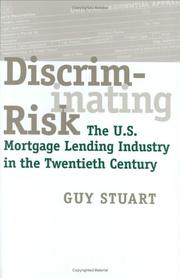
ISBN: 1501729969 9781501729966 0801440661 9780801440663 Year: 2003 Publisher: Ithaca
Abstract | Keywords | Export | Availability | Bookmark
 Loading...
Loading...Choose an application
- Reference Manager
- EndNote
- RefWorks (Direct export to RefWorks)
The U.S. home mortgage industry first formalized risk criteria in the 1920s and 1930s to determine which applicants should receive funds. Over the past eighty years, these formulae have become more sophisticated. Guy Stuart demonstrates that the very concepts on which lenders base their decisions reflect a set of social and political values about "who deserves what." Stuart examines the fine line between licit choice and illicit discrimination, arguing that lenders, while eradicating blatantly discriminatory practices, have ignored the racial and economic-class biases that remain encoded in their decision processes. He explains why African Americans and Latinos continue to be at a disadvantage in gaining access to loans: discrimination, he finds, results from the interaction between the way lenders make decisions and the way they shape the social structure of the mortgage and housing markets.Mortgage lenders, Stuart contends, are embedded in and shape a social context that can best be understood in terms of rules, networks, and the production of space. Stuart's history of lenders' risk criteria reveals that they were synthesized from rules of thumb, cultural norms, and untested theories. In addition, his interviews with real estate and lending professionals in the Chicago housing market show us how the criteria are implemented today. Drawing on census and Home Mortgage Disclosure Act data for quantitative support, Stuart concludes with concrete policy proposals that take into account the social structure in which lenders make decisions.
Race discrimination --- Discrimination in housing --- Mortgage loans --- Fair housing --- Housing, Discrimination in --- Open housing --- Race discrimination in housing --- Segregation in housing --- Housing --- United States --- Race relations. --- Race question
Book
ISBN: 0190063890 0190063904 0190063882 Year: 2021 Publisher: New York, New York : Oxford University Press,
Abstract | Keywords | Export | Availability | Bookmark
 Loading...
Loading...Choose an application
- Reference Manager
- EndNote
- RefWorks (Direct export to RefWorks)
This text examines how housing market professionals - including housing developers, real estate agents, mortgage lenders, and appraisers - construct twenty-first-century urban housing markets in ways that contribute to or undermine racial segregation. Drawing on extensive ethnographic and interview data collected in Houston, Texas, the book shows that housing market professionals play a key role in connecting people - or refusing to connect people - to housing resources and opportunities.
Discrimination in housing --- History --- Fair housing --- Housing, Discrimination in --- Open housing --- Race discrimination in housing --- Segregation in housing --- Housing --- Houston (Tex.) --- Race relations --- Houston City (Tex.)
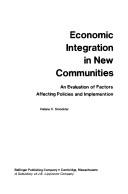
ISBN: 0884104575 Year: 1976 Publisher: Cambridge Ballinger
Abstract | Keywords | Export | Availability | Bookmark
 Loading...
Loading...Choose an application
- Reference Manager
- EndNote
- RefWorks (Direct export to RefWorks)
Discrimination in housing --- -New towns --- -New communities --- Satellite cities --- Cities and towns --- Fair housing --- Housing, Discrimination in --- Open housing --- Race discrimination in housing --- Segregation in housing --- Housing --- New towns --- -Discrimination in housing
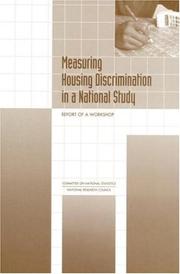
ISBN: 0309083257 9786610184545 128018454X 030950872X 9780309508728 9780309083256 0305083257 0309169860 Year: 2002 Publisher: Washington,DC : National Academy Press,
Abstract | Keywords | Export | Availability | Bookmark
 Loading...
Loading...Choose an application
- Reference Manager
- EndNote
- RefWorks (Direct export to RefWorks)
Discrimination in housing --- Discrimination in mortgage loans --- Research --- Race discrimination in mortgage loans --- Red lining --- Redlining --- Fair housing --- Housing, Discrimination in --- Open housing --- Race discrimination in housing --- Segregation in housing --- Mortgage loans --- Housing
Book
ISBN: 0231545576 9780231545570 9780231184601 0231184603 Year: 2019 Publisher: New York
Abstract | Keywords | Export | Availability | Bookmark
 Loading...
Loading...Choose an application
- Reference Manager
- EndNote
- RefWorks (Direct export to RefWorks)
The black ghetto is thought of as a place of urban decay and social disarray. Like the historical ghetto of Venice, it is perceived as a space of confinement, one imposed on black America by whites. It is the home of a marginalized underclass and a sign of the depth of American segregation. Yet while black urban neighborhoods have suffered from institutional racism and economic neglect, they have also been places of refuge and community.In A Haven and a Hell, Lance Freeman examines how the ghetto shaped black America and black America shaped the ghetto. Freeman traces the evolving role of predominantly black neighborhoods in northern cities from the late nineteenth century through the present day. At times, the ghetto promised the freedom to build black social institutions and political power. At others, it suppressed and further stigmatized African Americans. Freeman reveals the forces that caused the ghetto's role as haven or hell to wax and wane, spanning the Great Migration, mid-century opportunities, the eruptions of the sixties, the challenges of the seventies and eighties, and present-day issues of mass incarceration, the subprime crisis, and gentrification. Offering timely planning and policy recommendations based in this history, A Haven and a Hell provides a powerful new understanding of urban black communities at a time when the future of many inner-city neighborhoods appears uncertain.
African American neighborhoods --- Discrimination in housing --- Fair housing --- Housing, Discrimination in --- Open housing --- Race discrimination in housing --- Segregation in housing --- Housing --- Afro-American neighborhoods --- Neighborhoods, African American --- Ethnic neighborhoods --- Social conditions. --- Economic conditions. --- History. --- United States --- Race relations
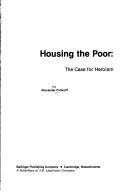
ISBN: 0884106659 Year: 1978 Publisher: Cambridge Ballinger
Abstract | Keywords | Export | Availability | Bookmark
 Loading...
Loading...Choose an application
- Reference Manager
- EndNote
- RefWorks (Direct export to RefWorks)
Social stratification --- Social problems --- Sociology of environment --- Discrimination in housing --- -Housing policy --- -Housing --- Housing and state --- State and housing --- City planning --- Social policy --- Fair housing --- Housing, Discrimination in --- Open housing --- Race discrimination in housing --- Segregation in housing --- Housing --- Government policy --- Housing policy --- -Discrimination in housing
Book
ISBN: 9062660525 Year: 1984 Publisher: Utrecht Rijksuniversiteit Utrecht. Geografisch instituut
Abstract | Keywords | Export | Availability | Bookmark
 Loading...
Loading...Choose an application
- Reference Manager
- EndNote
- RefWorks (Direct export to RefWorks)
Discrimination in housing --- Minorities --- Ethnic minorities --- Foreign population --- Minority groups --- Persons --- Assimilation (Sociology) --- Discrimination --- Ethnic relations --- Majorities --- Plebiscite --- Race relations --- Segregation --- Fair housing --- Housing, Discrimination in --- Open housing --- Race discrimination in housing --- Segregation in housing --- Housing --- Government policy --- Sociology of environment --- Utrecht
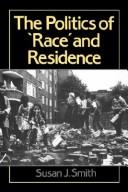
ISBN: 0745603580 0745603599 Year: 1989 Publisher: Cambridge Polity press
Abstract | Keywords | Export | Availability | Bookmark
 Loading...
Loading...Choose an application
- Reference Manager
- EndNote
- RefWorks (Direct export to RefWorks)
Discrimination in housing --- #SBIB:316.8H16 --- #SBIB:39A6 --- #SBIB:39A72 --- Fair housing --- Housing, Discrimination in --- Open housing --- Race discrimination in housing --- Segregation in housing --- Welzijns- en sociale problemen: migranten, rassenrelaties --- Etniciteit / Migratiebeleid en -problemen --- Etnografie: Europa --- Sociology of minorities --- Sociology of environment --- Great Britain --- Housing
Book
ISBN: 1000000850 0429280572 9781000000856 9780429280573 9781000014211 1000014215 9781000007695 1000007693 9781138358911 1138358916 Year: 2019 Publisher: New York : Routledge,
Abstract | Keywords | Export | Availability | Bookmark
 Loading...
Loading...Choose an application
- Reference Manager
- EndNote
- RefWorks (Direct export to RefWorks)
This book provides the first in depth interpretation of how to understand the causes of ethnic residential segregation across Western European countries and the USA. In many countries, ethnic minorities have obtained low quality housing and may be concentrated in certain parts of cities. This book asks to what extent ethnic segregation can be assigned to special preferences for housing and neighbourhoods among ethnic minorities. Is it the behaviour of the native majority, or is it a result of housing and urban policies? Ethnic segregation differs greatly across European countries and cities. Chapters discuss the extent to which these differences can be explained by welfare state systems, levels of immigration and the ethnic composition of minorities. The book also considers the impact of housing policy and the spatial structure of urban housing markets created by urban planning and policies. This book will appeal to teachers, students and researchers working with segregation, urban sociology and geography. It will also be valuable to civil servants in central and local governments who are working with measures to combat ethnic segregation and its consequences.
Minorities --- Discrimination in housing --- Fair housing --- Housing, Discrimination in --- Open housing --- Race discrimination in housing --- Segregation in housing --- Housing --- Ethnic minorities --- Foreign population --- Minority groups --- Persons --- Assimilation (Sociology) --- Discrimination --- Ethnic relations --- Majorities --- Plebiscite --- Race relations --- Segregation --- minoriteter --- diskriminering --- boliger --- boligforhold --- Europa
Book
ISBN: 0801459680 0801459974 9780801459979 Year: 2010 Publisher: Ithaca, NY : Cornell University Press,
Abstract | Keywords | Export | Availability | Bookmark
 Loading...
Loading...Choose an application
- Reference Manager
- EndNote
- RefWorks (Direct export to RefWorks)
From 1963 to 1965 roughly 6,000 families moved into Rochdale Village, at the time the world's largest housing cooperative, in southeastern Queens, New York. The moderate-income cooperative attracted families from a diverse background, white and black, to what was a predominantly black neighborhood. In its early years, Rochdale was widely hailed as one of the few successful large-scale efforts to create an integrated community in New York City or, for that matter, anywhere in the United States.Rochdale was built by the United Housing Foundation. Its president, Abraham Kazan, had been the major builder of low-cost cooperative housing in New York City for decades. His partner in many of these ventures was Robert Moses. Their work together was a marriage of opposites: Kazan's utopian-anarchist strain of social idealism with its roots in the early twentieth century Jewish labor movement combined with Moses's hardheaded, no-nonsense pragmatism. Peter Eisenstadt recounts the history of Rochdale Village's first years, from the controversies over its planning, to the civil rights demonstrations at its construction site in 1963, through the late 1970's, tracing the rise and fall of integration in the cooperative. (Today, although Rochdale is no longer integrated, it remains a successful and vibrant cooperative that is a testament to the ideals of its founders and the hard work of its residents.) Rochdale's problems were a microcosm of those of the city as a whole-troubled schools, rising levels of crime, fallout from the disastrous teachers' strike of 1968, and generally heightened racial tensions. By the end of the 1970's few white families remained. Drawing on exhaustive archival research, extensive interviews with the planners and residents, and his own childhood experiences growing up in Rochdale Village, Eisenstadt offers an insightful and engaging look at what it was like to live in Rochdale and explores the community's place in the postwar history of America's cities and in the still unfinished quests for racial equality and affordable urban housing.
Housing, Cooperative --- Discrimination in housing --- Co-housing --- Co-ops (Housing) --- Cohousing --- Cooperative housing --- Housing cooperatives --- Mutual housing --- Common interest ownership communities --- Cooperation --- Communal living --- Fair housing --- Housing, Discrimination in --- Open housing --- Race discrimination in housing --- Segregation in housing --- Housing --- History. --- Moses, Robert, --- Rochdale Village (Queens, NY) --- History --- Rochdale Village (New York, N.Y.)
| Listing 1 - 10 of 34 | << page >> |
Sort by
|

 Search
Search Feedback
Feedback About
About Help
Help News
News